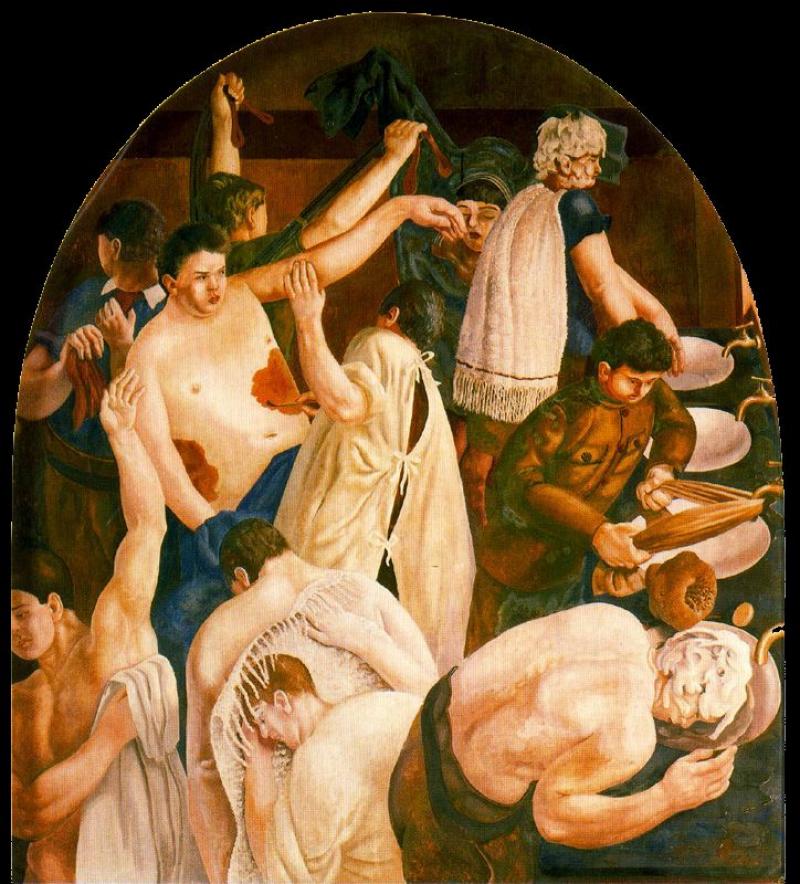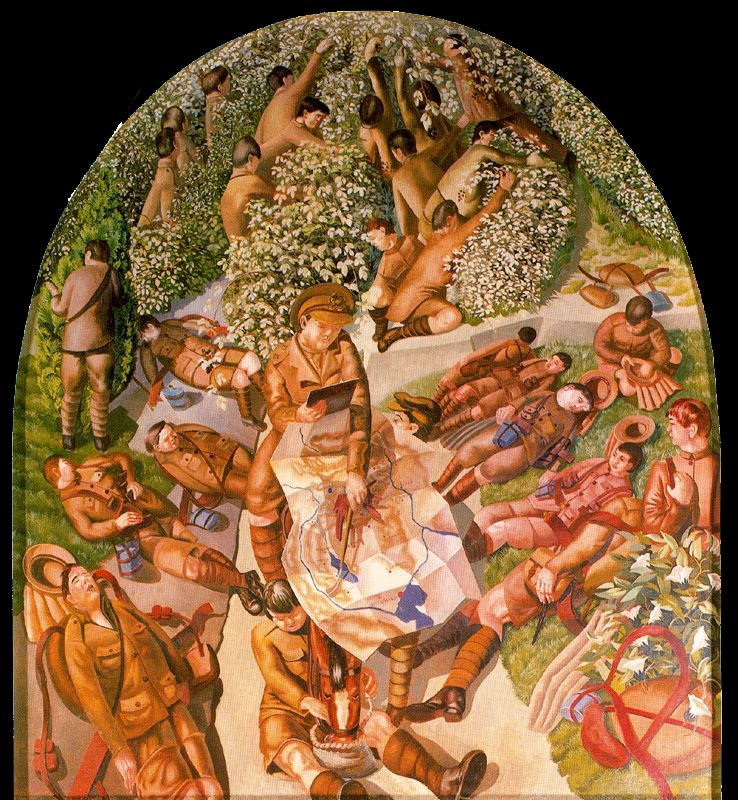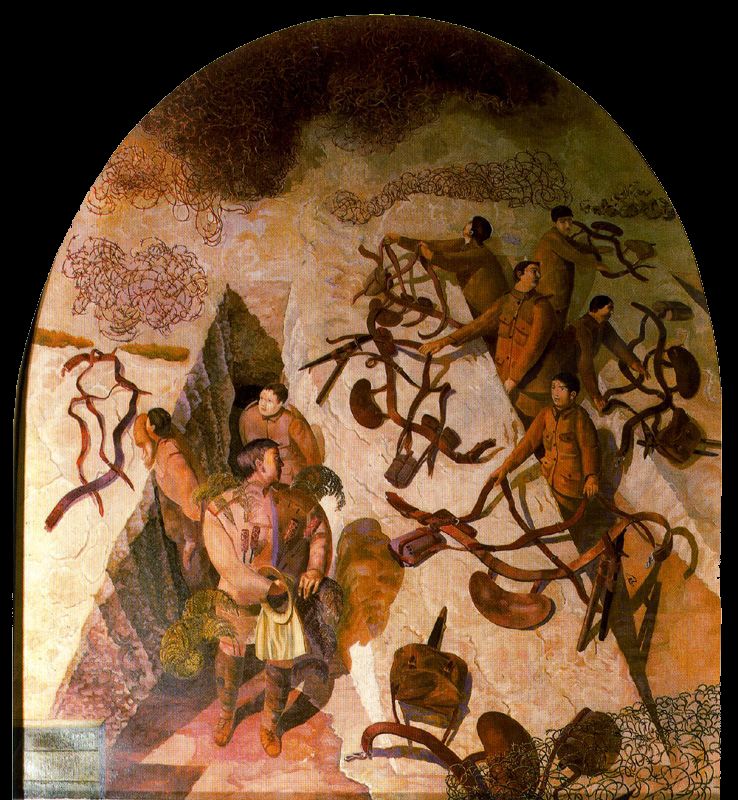Stanley Spencer: Heaven in a Hell of War, Somerset House | reviews, news & interviews
Stanley Spencer: Heaven in a Hell of War, Somerset House
Stanley Spencer: Heaven in a Hell of War, Somerset House
Away from the dimly lit chapel for which they were painted, we can see Spencer's war paintings in painstaking detail

Stanley Spencer’s painting Map Reading shows us, in dizzying perspectives and changes of scale, a mounted cavalry officer reading a huge unfurled map concerning the now forgotten campaign in Macedonia in World War I, his horse nibbling oats all the while. Clustered all around his giant figure, ordinary soldiers surround their commander, fanned out at oblique angles to his central figure.
Somerset House provides an unrepeatable experience, as we are able to see the newly restored paintings close up in bright light
Map Reading (pictured below) is but one of the commemorative 16 paintings – lunettes and predellas – which are visiting London while their normal home, the modest (but listed Grade I) red brick 1920s Sandham Memorial Chapel in Burghclere, Hampshire, now in the care of the National Trust, is conserved and restored. Three wall murals including the Resurrection, here in a major back-lit reproduction, could not be moved for this unprecedented visit to London, an exhibition Stanley Spencer (1891-1959) had passionately wished for. He knew their quality, because of his own extraordinary view of life which combined confidence and diffidence, naiveté and sophistication.
 The paintings were inspired by Spencer’s own war experience, and were six years in the making (1926-1932). They were modelled in some ways on Giotto’s early 14th-century Arena Chapel in Padua in terms of their three-tier stacking. They have Spencer’s highly unusual combination of the spiritual and the earthly, the imaginative and the real, and the quotidian and the miraculous; in that sense they also very subtly echo the ethos of Giotto’s extraordinary introduction of the realistic and the believable into the miraculous.
The paintings were inspired by Spencer’s own war experience, and were six years in the making (1926-1932). They were modelled in some ways on Giotto’s early 14th-century Arena Chapel in Padua in terms of their three-tier stacking. They have Spencer’s highly unusual combination of the spiritual and the earthly, the imaginative and the real, and the quotidian and the miraculous; in that sense they also very subtly echo the ethos of Giotto’s extraordinary introduction of the realistic and the believable into the miraculous.
The scenes are partly set in Macedonia, the campaign in which Spencer took part, and in the Beaufort War Hospital, Bristol, where he also served. In Ablutions (main picture) there is almost a sense of the wounded saint, as the sturdy half-naked solider has iodine painted on his chest wounds, while elsewhere muscled men wash themselves aided by male and female nurses in the communal hospital bathroom.
Convoy Arriving with the Wounded is just that, an open lorry carrying the helmeted soldiers, each of whom has an arm in a shining white sling, the lorry improbably surrounded by rhododendron blossom; two enormous men, one with a cluster of keys at his waist, open high iron gates to let the lorry through into the hospital. Other hospital scenes show orderlies sorting out fat padlocked black kit-bags in grim prison-like surroundings – the hospital treated both the war-wounded and the shell-shocked. Scrubbing the Floor has as its focus a shell-shoked solder prostrate in a corridor, obviously ritualistically washing the same area of dirty floor. Above this abject figure a trio of bustling workers, oblivious to his plight, carry trays of bread for the patients.
 Dug Out (pictured above) is set at the front in Salonika with soldiers standing in two trenches with their equipment laid out in front of them, their sergeant, his own uniform partly camouflaged, looking toward them; barbed wire is at the front of the image. The mood is both tense and curiously serene: Spencer wrote that he had thought how marvellous it would be if one morning we came out of our dug-outs, and somehow everything was at peace and war had ended. Reveille is also a concatenation of contradictory moods. Soldiers are leaning into a vast tent, announcing that the war is over; at the apex of the tent there are clusters of scores of insects, menacing yet passive. The tent is filled with three standing figures wrapped in elaborate mosquito nets, like transparent graves, seemingly about to burst free from their entanglement. In Spencer’s iconography, these awakened but still entrapped figures may not only soon be free, but even redeemed.
Dug Out (pictured above) is set at the front in Salonika with soldiers standing in two trenches with their equipment laid out in front of them, their sergeant, his own uniform partly camouflaged, looking toward them; barbed wire is at the front of the image. The mood is both tense and curiously serene: Spencer wrote that he had thought how marvellous it would be if one morning we came out of our dug-outs, and somehow everything was at peace and war had ended. Reveille is also a concatenation of contradictory moods. Soldiers are leaning into a vast tent, announcing that the war is over; at the apex of the tent there are clusters of scores of insects, menacing yet passive. The tent is filled with three standing figures wrapped in elaborate mosquito nets, like transparent graves, seemingly about to burst free from their entanglement. In Spencer’s iconography, these awakened but still entrapped figures may not only soon be free, but even redeemed.
The exhibition, in three galleries, is of course not the same as when visiting the chapel, where the viewer is literally and metaphorically absorbed in these teeming scenes of hope and despair, suffering and redemption.
However, the chapel is necessarily dimly lit, its details hard to see. Somerset House provides an unrepeatable experience, as we are able to see the newly restored paintings close up in bright light, appreciate the dizzying changes of scale, and the detail, often almost exquisite, of tent and military uniform and kit, the sand and arid landscape of Macedonia, the prison-like aspect of the Bristol hospital, the explosions of foliage and blossom. All is in a restricted range of colours – ochres, reds, rusts, browns, whites, occasional deep blues – which nevertheless convey bursts of light. Facial expressions are almost uniformly wooden, any liveliness apparent in body language. Spencer, through his own intensely idiosyncratic, eccentric, inimitable idiom, somehow conveys a range of expressions from acceptance, through resignation, to hope. He continually plays with the passive – the sleeping men – and the active, the hospital orderlies, the soldiers anticipating action.
Above all, in his elaborate, crowded, convincing compositions, Spencer is attentive to conveying through a myriad of details, the men at the heart of war – and peace.
Explore topics
Share this article
The future of Arts Journalism
You can stop theartsdesk.com closing!
We urgently need financing to survive. Our fundraising drive has thus far raised £33,000 but we need to reach £100,000 or we will be forced to close. Please contribute here: https://gofund.me/c3f6033d
And if you can forward this information to anyone who might assist, we’d be grateful.

Subscribe to theartsdesk.com
Thank you for continuing to read our work on theartsdesk.com. For unlimited access to every article in its entirety, including our archive of more than 15,000 pieces, we're asking for £5 per month or £40 per year. We feel it's a very good deal, and hope you do too.
To take a subscription now simply click here.
And if you're looking for that extra gift for a friend or family member, why not treat them to a theartsdesk.com gift subscription?
more Visual arts
 Help to give theartsdesk a future!
Support our GoFundMe appeal
Help to give theartsdesk a future!
Support our GoFundMe appeal
 Ed Atkins, Tate Britain review - hiding behind computer generated doppelgängers
Emotions too raw to explore
Ed Atkins, Tate Britain review - hiding behind computer generated doppelgängers
Emotions too raw to explore
 Echoes: Stone Circles, Community and Heritage, Stonehenge Visitor Centre review - young photographers explore ancient resonances
The ancient monument opens its first exhibition of new photography
Echoes: Stone Circles, Community and Heritage, Stonehenge Visitor Centre review - young photographers explore ancient resonances
The ancient monument opens its first exhibition of new photography
 Hylozoic/Desires: Salt Cosmologies, Somerset House and The Hedge of Halomancy, Tate Britain review - the power of white powder
A strong message diluted by space and time
Hylozoic/Desires: Salt Cosmologies, Somerset House and The Hedge of Halomancy, Tate Britain review - the power of white powder
A strong message diluted by space and time
 Mickalene Thomas, All About Love, Hayward Gallery review - all that glitters
The shock of the glue: rhinestones to the ready
Mickalene Thomas, All About Love, Hayward Gallery review - all that glitters
The shock of the glue: rhinestones to the ready
 Interview: Polar photographer Sebastian Copeland talks about the dramatic changes in the Arctic
An ominous shift has come with dark patches appearing on the Greenland ice sheet
Interview: Polar photographer Sebastian Copeland talks about the dramatic changes in the Arctic
An ominous shift has come with dark patches appearing on the Greenland ice sheet
 Donald Rodney: Visceral Canker, Whitechapel Gallery review - absence made powerfully present
Illness as a drive to creativity
Donald Rodney: Visceral Canker, Whitechapel Gallery review - absence made powerfully present
Illness as a drive to creativity
 Noah Davis, Barbican review - the ordinary made strangely compelling
A voice from the margins
Noah Davis, Barbican review - the ordinary made strangely compelling
A voice from the margins
 Best of 2024: Visual Arts
A great year for women artists
Best of 2024: Visual Arts
A great year for women artists
 Electric Dreams: Art and Technology Before the Internet, Tate Modern review - an exhaustive and exhausting show
Flashing lights, beeps and buzzes are diverting, but quickly pall
Electric Dreams: Art and Technology Before the Internet, Tate Modern review - an exhaustive and exhausting show
Flashing lights, beeps and buzzes are diverting, but quickly pall
 ARK: United States V by Laurie Anderson, Aviva Studios, Manchester review - a vessel for the thoughts and imaginings of a lifetime
Despite anticipating disaster, this mesmerising voyage is full of hope
ARK: United States V by Laurie Anderson, Aviva Studios, Manchester review - a vessel for the thoughts and imaginings of a lifetime
Despite anticipating disaster, this mesmerising voyage is full of hope

Add comment